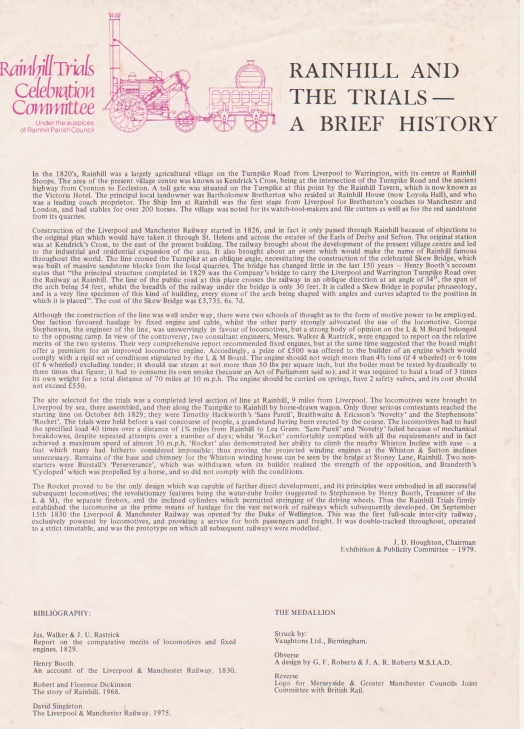Rainhill and the Trials - A Brief History
Resource Type: Image | Posted on 12th December 2011 by Liam Physick
This leflet, issued by the Rainhill Trials Celebration Committee in 1979 to coincide with Rocket 150, gives a description of Rainhill at the time of the Trials and summarises the Trials themselves. It notes that Rainhill was only included in the Liverpool and Manchester Railway route because because of objections raised by the Earls of Derby and Sefton, through whose estates the original route was scheduled to pass, and that the Railway contributed to the industrial development of the village. It also mentions the famous Skew Bridge. Some context to the Rainhill Trials is provided: while Stephenson favoured the use of locomotives to haul the trains, many on the Railway Company board favoured fixed engines, so two consultant engineers, James Walker and John Urpeth Rastrick, were commissioned to report on the merits of the two forms of motive power. They favoured fixed engines on the grounds of cost, but also recommended that the board put up a premium for a locomotive more advanced than those then in existence, as locomotives were likely to be improved over time. The stipulation of the Trials was that each locomotive had to haul a train three times its own weight 40 times over the one and three quarter miles between Rainhill and Lea Green (the equivalent of the distance between Liverpool and Manchester and back). The Rocket’s performance at the Trials settled the argument conclusively in favour of locomotives, as it proved able to travel at 30 miles per hour (to put that into context, the conditions of the Trials only required 10 miles per hour) and to climb the Whiston Incline (previously seen as an impossible feat for a locomotive). The leaflet concludes by mentioning the revolutionary features of the Liverpool and Manchester Railway: “This was the first full-scale inter-city railway, exclusively powered by locomotives [excluding the fixed engines used to take passengers from Edge Hill to Crown Street], and providing a service for both passengers and freight. It was double-tracked throughout, operated to a strict timetable, and was the prototype on which all subsequent railways were modelled.”, fix
Categorised under: The Station & Railway Pioneers

Comments